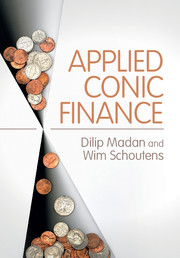Book contents
- Frontmatter
- Dedication
- Contents
- Preface
- Acknowledgements
- 1 Financial Mathematics Principles
- 2 Stochastic Processes and Financial Models
- 3 Numerical Techniques
- 4 Conic Finance
- 5 Conic Pricing
- 6 Applications of Conic Finance
- 7 Conic Portfolio Theory
- 8 Conic Hedging
- 9 Hedging Insurance Contracts
- 10 Option Positioning
- 11 Conic Trading
- References
- Index
3 - Numerical Techniques
Published online by Cambridge University Press: 27 October 2016
- Frontmatter
- Dedication
- Contents
- Preface
- Acknowledgements
- 1 Financial Mathematics Principles
- 2 Stochastic Processes and Financial Models
- 3 Numerical Techniques
- 4 Conic Finance
- 5 Conic Pricing
- 6 Applications of Conic Finance
- 7 Conic Portfolio Theory
- 8 Conic Hedging
- 9 Hedging Insurance Contracts
- 10 Option Positioning
- 11 Conic Trading
- References
- Index
Summary
In this chapter we discuss several numerical implementation issues.More precisely, we focus first on several techniques to efficiently calculate the price of a vanilla derivative under advanced models. We use these efficient pricers in a second part in which we focus on the calibration problem: how to determine the (risk-neutral) parameters of a given model, such that we get the best possible match with the dynamics of the underlying asset we are focusing on. Finally, we elaborate on how to perform a Monte Carlo simulation or, in other words, how to simulate several/numerous paths of the underlying under a given model with a given (calibrated) parameter set. This is particularly useful for the pricing of exotic options, where one estimates the price of the exotic as the discounted average payoff over the (many) simulated paths.
Pricing of Vanilla Options
Pricing Vanilla Options Using Characteristic Functions and FFT Techniques
In this section, we describe how one can very quickly and efficiently price vanilla options using the theory of characteristic functions and Fast Fourier Transforms (FFT). The method is particularly interesting in the case of advanced equity models, like the Variance Gamma model, and many other models (e.g. the Heston model) where no closed-form solutions for vanillas exist.
An important advantage of the method is that the pricer only needs as input the characteristic function of the dynamics of the underlying model. More precisely, the characteristic function of the logarithm of the stock price at the relevant maturity. If one wishes to switch to another model, only the corresponding characteristic functions need to be changed and the actual pricing algorithm remains untouched. The methodology can be applied not only to vanillas, but typically also to more general options which depend only on the stock price at maturity, such as digitals.
Furthermore, a lot of the so-called greeks (Delta,Gamma, … ; see Section 3.1.2) of the classical vanilla options can also be calculated using a similar procedure.
Information
- Type
- Chapter
- Information
- Applied Conic Finance , pp. 52 - 76Publisher: Cambridge University PressPrint publication year: 2016
